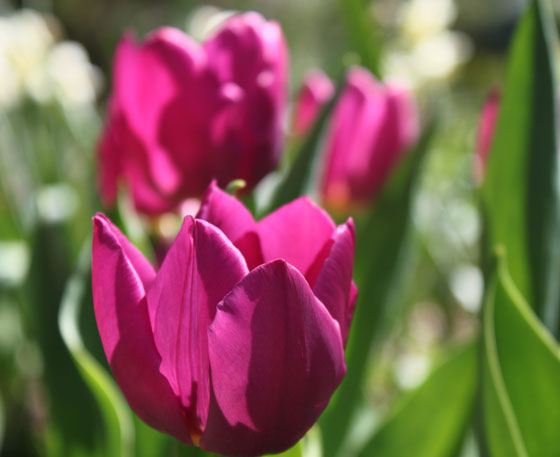Bulbs
are a wonderful thing. You bury the ugly little globs in the fall and in the spring
gorgeous blooms burst forth, as if by magic. But now is the time to prepare for
the show.
There
are a few things you can do to make your spring display a sensation. First, as with any garden, you should
know your soil conditions (Penn State Extension offers soil tests that provide
all the information you need). The optimum pH range for bulbs is 6 to 7. (The
soil test results will indicate if lime needs to be applied to adjust the soil
pH.) Bulbs also need good drainage or they will rot. If you have soil with high
clay content, add compost, peat moss, or some other type of organic material to
help it drain better. The organic material should be worked into the top 12-18
inches of soil.
All
bulbs like sun, but keep in mind that many spring bulbs bloom before the trees
leaf out, so you can plant them in areas that become shady later in the season
but get sun in the early spring.
Spring-blooming
bulbs can be planted in late fall, up until the ground is frozen, but not more
than six weeks before the first frost. For optimum results, mix bone meal into
the soil at the bottom of the hole and if bulbs are going to be kept in a
planting bed for more than one year, supply additional fertilizer. Mix 5
tablespoons of 10-10-10 soluble fertilizer (or equivalent bulb fertilizer) plus
two cups of bone meal per ten square foot area into the soil in the fall. Do
not allow the bulbs to touch fertilizer.
The
general rule of thumb is to plant bulbs two to three times as deep as they are
tall, measuring from the bottom of the bulb. This means most large bulbs like
tulips or daffodils will be planted about 8 inches deep while smaller bulbs
will be planted 3-4 inches deep. Summer bulbs have varied planting
requirements, so consult the information supplied with the bulbs for proper
planting depth.
Most
bulbs are planted with the pointed end up and the root plate down. The best
method of planting is to dig the entire bed to the proper depth, adding fertilizer,
bone meal, and any amendments. Press the bulbs into the soil in the planting
area and cover with soil. Cover the bulb bed with two or three inches of mulch.
Mulch will help minimize temperature fluctuation and maintain an optimal
moisture level in the planting bed. Small, early-blooming bulbs should not be
mulched.
Water
the bulbs after planting. This helps settle the soil and provides moisture for
the bulbs to start
rooting. Fall-planted bulbs must root before cold weather. Avoid over-watering
at planting time since this can result in bulb rot.
For
both spring and summer bulbs, water whenever the soil is dry, any time after
the flower buds first appear on the plant. Fertilize monthly from shoot
emergence until the plants reach full flower. After blooming, allow the leaves
of the plant to wither and turn brown; do not cut or mow them. The plant needs
the leaves to manufacture food (through photosynthesis) to be stored in the
bulb for next year’s growth. After the foliage is completely shriveled, bulbs
can be left in place or dug up and replanted in the fall.
Tips
for Gardening with Bulbs
· During
the growing season, water to keep soil moist but not soggy.
· Weed
frequently, as weeds take nourishment away from seedlings and bulbs.
· Fertilize
several times a season.
· Scatter
daffodils in clumps for a more natural look. They never have to be dug and are
rabbit and deer resistant.
· To
disguise dying foliage, place bulbs behind other plants or interplant with annuals.
Plant taller bulbs behind low-growing plants, or use groundcovers and
perennials like hosta or daylilies in front.
· For
the most natural look, plant bulbs in clumps or swaths, not straight lines.
* Nancy Sakaduski is the Chester County
Master Gardener Coordinator. Master Gardeners are trained volunteers who
educate the public on gardening and horticultural issues. In Chester
County, they operate through the Penn State Cooperative Extension office in
West Chester. Nancy lives in Pennsbury Township. She can be reached
at nds13@psu.edu.
About Nancy Sakaduski
Nancy Sakaduski is a Master Gardiner with Penn State Extension of Chester County.





Comments